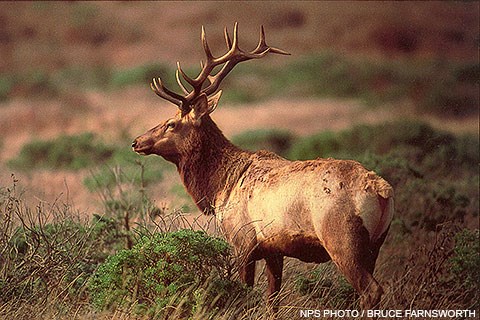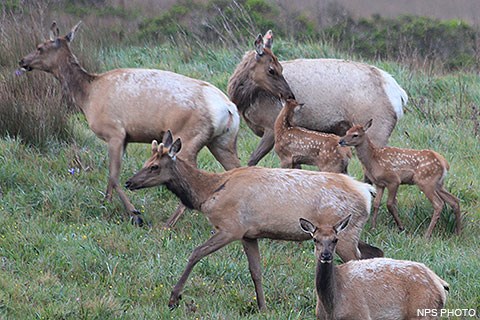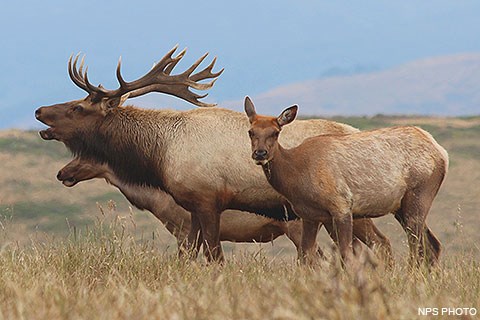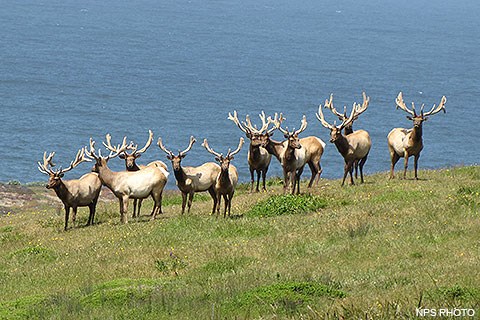Tomales Point Tule Elk Reserve UpdateFor details about water availability and the management of tule elk at Tomales Point, visit our Tule Elk at Tomales Point Frequently Asked Questions page. 
History of Tule ElkThe tule elk (Cervus canadensis nannodes) is one of two subspecies of elk native to California. Its numbers were severely reduced in the mid-1800s, primarily due to uncontrolled market hunting and displacement by cattle. By some accounts, fewer than thirty remained in a single herd near Bakersfield in the mid-1870s. A conservation minded cattle rancher named Henry Miller had the foresight to preserve this last isolated group discovered on his ranch in 1874. Until this discovery, tule elk were thought to be extinct. All of the estimated 5,700 tule elk present in twenty-two herds across California (as of 2020) were derived from this small remnant herd, thanks to his initial efforts. Tule elk are endemic to California, meaning they are found only here. Roosevelt elk (C. canadensis roosevelti), our other native California elk, are found on forested slopes in the Pacific Northwest and in several other western states. Rocky Mountain elk (C. canadensis nelsoni), also found in California, are a non-native transplant and are found in the northeast corner of California. 
Tule Elk at Point ReyesTule elk once inhabited the grasslands of the Point Reyes peninsula and the Olema Valley, as well as other grasslands within Marin County. They were the dominant grazers on these lands until their local extirpation in the 1850s. State and Federal legislation in the early 1970s, authorized the California Department of Fish and Game, in cooperation with U.S. Fish and Wildlife Service and the National Park Service, to reintroduce the extirpated tule elk to Tomales Point. As a result, ten animals (eight females and two males) were transplanted from an existing reintroduced herd in the San Luis National Wildlife Refuge near Los Baños to a 2,600-acre fenced enclosure on Tomales Point in 1978. The site of this release was a decommissioned cattle ranching area, known as Pierce Ranch, which is now designated as wilderness. In 2019, the National Park Service increased the size of the reserve to 2,900 acres. Further conservation efforts resulted in an additional free-ranging herd being established at Point Reyes. In 1998, twenty-eight animals taken from the Tomales Point preserve were released in the wilderness area south of Limantour Beach. Reintroduction of tule elk to the National Seashore and the further establishment of the free-ranging herd has been an important component of the restoration of the natural systems historically found in this unique and treasured place. 
Tule Elk Populations at Tomales PointFollowing an initial period of slow growth, the tule elk herd at Tomales Point grew exponentially over several years. In the early 1990s, biologists theorized that tule elk might become too numerous within the Tule Elk Reserve. At that time, park staff attempted to prevent over-population and damage to the range through various means, including an experimental four-year effort to slow growth through the use of contraceptives. Since 2020, the elk population at Tomales Point has fluctuated up and down with changing environmental conditions, with a low census count of 283 individuals in 2015 to a high count of 585 individuals in 2007, and an average of approximately 420 individuals over the last 20 years from 1999 to 2019. The low census count of 283 individuals in 2015 was likely a result of overpopulation and poor forage conditions during the dry summer and fall months. The tule elk at Tomales Point had access to water throughout the 2012–2015 drought years. The 1998 Tule Elk Management Plan and Environmental Assessment (EA) (10,680 KB PDF) guides the management of elk at Tomales Point, and notes that the population of elk at this location may go through a series of modulated swings of population growth and decline, a process called natural- or self-regulation. The 2023 annual census of tule elk identified a minimum population size of 315 individuals at Tomales Point, a 20.2% increase from 262 elk in 2022. 
Free-Ranging PopulationsOf the forty-five elk transported to a holding pen for quarantine near Limantour Beach, twenty-eight animals were cleared for release following screening for Johne's disease. Johne's disease, or paratuberculosis, is a chronic diarrheal disease of domestic livestock and can affect wild ruminants. After relocation from Tomales Point to the Limantour area, several elk were observed to have traveled across Drakes Estero where they established a sub-herd near Drakes Beach. In 2012, over fifty-five elk inhabited the Drakes Beach area while over sixty-five remained in the Limantour area. By 2023, the populations had increased to 188 elk in the Drakes Beach area and 199 elk in Limantour area. Opportunities for wildlife viewing have been greatly enhanced by the presence of these herds, and visitors can expect to view and photograph tule elk at Point Reyes even if they never travel to Tomales Point. Point Reyes National Seashore remains the only National Park unit where tule elk can be found. The majestic animals you see as you travel through the park embody the restoration of the dominant native herbivore to the California coastal ecosystem. They shape the landscape around them as they did for centuries before they were extirpated by humans. They symbolize the conservation of native species and ecosystem processes, one of the primary missions of the National Park Service. The tule elk's presence is treasured by visitors, photographers, naturalists, and locals alike. Their image has been expressed in the local folk art, numerous local and nationally published photographs, and even on the local trade/barter currency where they are depicted alongside cattle, coho salmon, and local produce as being emblematic of the community. The project to reintroduce free-ranging tule elk to the Limantour area was made possible by generous grants from:
Discover more about the tule elk by reading Tule Elk - Return of a Species (377 KB PDF, Adobe® Acrobat Reader® may be needed to view document), or by visiting our Viewing Tule Elk webpage. Even more information can be found on the Pacific Coast Science and Learning Center's Tule Elk web pages and on the California Department of Fish and Wildlife's Tule Elk pages. Volunteer to be a Tule Elk Docent during weekends, July through September, at Point Reyes National Seashore. Tule Elk Management
Tule Elk Monitoring and Management at Point Reyes National Seashore Reports
MultimediaRead More about the Tule Elk at Point ReyesScience & Research Project SummariesFrom 2006 to 2018, Point Reyes National Seashore and Pacific Coast Science and Learning Center (PCSLC) staff and communication interns assisted scientists conducting research through the PCSLC and the San Francisco Bay Area Inventory & Monitoring Network to produce a series of Resource Project Summaries, one of which was about tule elk at Point Reyes. These one- to eight-page summaries provide information about the questions that the researchers hoped to answer, details about the project and methods, and the results of the research projects in a way that is easy to understand.
|
Last updated: December 26, 2024
